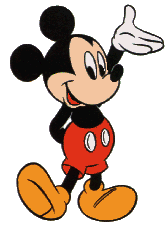 I wrote the following article, which the LA Reader (a weekly alternative newspaper) published 3/25/94:
I wrote the following article, which the LA Reader (a weekly alternative newspaper) published 3/25/94: I wrote the following article, which the LA Reader (a weekly alternative newspaper) published 3/25/94:
I wrote the following article, which the LA Reader (a weekly alternative newspaper) published 3/25/94:
The Whitest Place in the World
Walt Disney Company is planning two new theme parks: the WESTCOT extension to Disneyland, with four global villages, and Disney's America, a view of U.S. history. Should we be worried? What can we infer about Disney's multicultural awareness from Disneyland, its flagship park?
Betty Jones, faculty member in human development at Pacific Oaks College, says, "Disneyland has been an effort to present to an enormously lucrative market an image of old-fashioned, European-American tradition. It's clean and it's beautiful and there's nobody scary there."
Certainly you won't see many African Americans. Apart from Captain Eo, you're most likely to encounter them on the Jungle Cruise. This ride isn't just politically incorrect, it's historically, geographically, and biologically incorrect as well.
The boats float along the "Nile" through the "jungles" of Africa. But the Nile doesn't pass through jungles, nor are jungles a significant part of the African terrain. The native porters, who should know wildlife best, cower like children from a rhinoceros attack. A water buffalo, a domestic animal found only in Asia, adds menace to the "dark" continent. And a "savage" offers skulls as arts and crafts, though there weren't any headhunting tribes in Africa.
You won't see many Latinos or Asians depicted at Disneyland, but at least Arabs appear in the "Aladdin" parade, if you consider sword twirlers and exotic dancers Arabic. You won't catch Arabs praying, philosophizing, or preserving Western thought through the Middle Ages, however.
"If all you show is a camel, and a belly dancer, and a fat guy in a white robe and dark glasses," says Don Bustany, president of the Arab-American Anti-Discrimination Committee in Los Angeles, "that is like showing black people with big, white, toothy grins and a slab of watermelon in their hands, or a Mexican sleeping under a sombrero, or a Jew standing under the three balls of a pawn shop."
Indians don't fare well, either. They're still the bad guys in "Peter Pan," though they're no longer responsible for the log cabin's flames. A chief, incongruously wearing ceremonial garb while on horseback, simply watches the house burn.
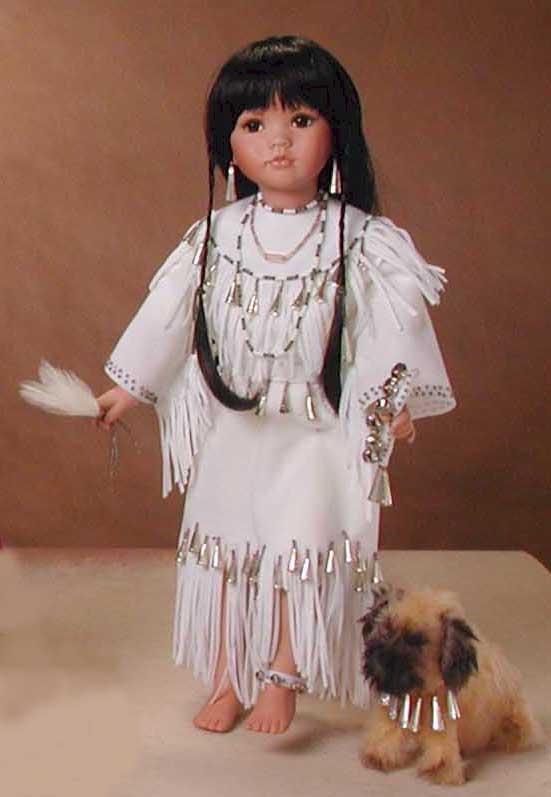
One store in Frontierland sells doe-eyed Minnehaha dolls and Crow "princesses," with incorrect features and costumes, and magnets with faces like Little Black Sambo's. Paula Roubideau, assistant executive director of the Southern California Indian Center, calls these items "a joke, a way of making money. Back in those days we did not have princesses like the European royalty."
A cigar-store Indian, the icon of "noble savagery," stands stoically on Main Street. But worse is a cigar-store bear dressed as an Indian in a corner of Critter Country. Imagine going to Caucasian-Land and seeing a dog as the President or a pig as an astronaut. Not a very flattering picture (though some might argue about the dog).
"When I see things like that," says Roubideau, "my immediate response is just pure ignorance on the part of the company. Why are we looked upon in the negative, past tense? Why are we always forgotten?"
The sine qua non of Disneyland's multicultural experience is "It's a Small World." Dave Okura, a former anthropology student who has visited the park about 30 times, finds it so objectionable he won't go in anymore. "Almost everything they have those little puppets or dolls doing is stereotyped," says Okura.
To begin with, the ride is noticeably Eurocentric. Countries such as England, Ireland, France, Germany, Switzerland, Italy, and the Netherlands come first. Each has its own display, while equally large and prominent countries—Brazil, Nigeria, Pakistan, Indonesia—get nothing.
While each scene reinforces a hackneyed image, not all images are created equal. The Europeans—a British beefeater, a German watchmaker, an Italian gondolier—are people working at jobs, living more or less respectably. Meanwhile, the Mexican peasant sells trinkets with his burro, the Arab flies on a magic carpet, and Africans beat drums and dance with wild animals, as if this were their natural state. (Can't you just see Nelson Mandela and a hippo?)
Europeans aren't shown in castles, nor Americans in cabins, but indigenous people are portrayed as they might have been hundreds of years ago. An Inuit ice-fishes; an aborigine throws a boomerang; a Pacific Islander seems wreathed in flames. (Is this supposed to be a volcanic sacrifice?) You won't learn that these people practice law, operate computers, or run for office nowadays.
"All those images, each of them, is true," says Bustany. "You can find living proof for any one of those. But that's like depicting one hair on a tail of an elephant as the elephant."
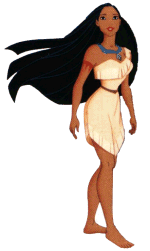
In short, what has Walt Disney wrought? "Clearly," says Jones, the company has "created a whole mythology of stories that a great many people resonate to. I think the images have often been stereotyped, and it may difficult not to do that when one is doing simplified versions of complex stories." She does believe Disney has made "some efforts," especially in its movies, "to express social concerns of one sort or another."
But is that enough? "Disney has a powerful role in molding our future," says Roubideau. "A lot of young people go through [Disneyland], not just from our own country but from all over the world." With that type of platform, she suggests, "Disney should feel obligated to make cultural decisions in an appropriate way."
Unfortunately, when I called a senior publicist at Disneyland about these matters, he refused to discuss them, said they were the Imagineering division's responsibility, and hung up on me. An employee at Imagineering told me to send my questions in writing, which I did. I never received a response.
If the attitude of Disney's people is representative, can we expect the cultural mistakes and stereotypes to continue? If the firm even refuses to discuss such concerns, what does it bode for the future? Perhaps the investors and taxpayers financing Disney's coming attractions should look at them closely before committing their dollars.
Note: The sensationalist "Whitest Place" headline was the Reader's choice, not mine. I've used my original title.
Disneyland 2001
Fortunately, the problematical WESTCOT expansion and Disney's America never came to pass. I haven't been to Disneyland since I wrote this essay, but a recent article shows change is coming slowly, if at all. From the LA Times, 9/3/01:
Disneyland Is Now Safe for Hippos
Anaheim: Bowing to modern sensibilities, officials disarm skippers of the Jungle Cruise.
By KIMI YOSHINO, Times Staff Writer
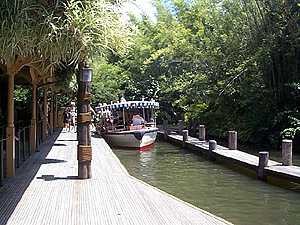
They took away the wench-chasing pirates. Now, they've stopped shooting the hippos.
Disneyland officials, who say they're only keeping up with today's sensibilities, have quietly disarmed the skippers of the Jungle Cruise, raising eyebrows among fans of one of the park's oldest, most cherished attractions.
No more do the wisecracking skippers reach for their Smith & Wessons and fire a few blanks at hippopotamuses emerging from the river bottom. These days, they don't even try to scare the mechanical creatures with a few haphazard gunshots skyward.
The guns were yanked at the Anaheim park this spring and now the hippos are just another passing attraction during an African-themed cruise.
"It's sad to see the tradition go," said former skipper Mike DeForest, who once spent his summer breaks from college guiding visitors through the jungle. 'What's next, disarming the Pirates of the Caribbean?"
The hippos may have a second lease on life, but the cruise still is filled with plenty of politically incorrect characters: a gun-wielding gorilla, savages toting shrunken heads and "natives" with painted faces preparing to attack the tourists.
Disneyland has always struggled to strike a balance between fantasy and political reality. Guns, the treatment of animals, racial and gender stereotypes all have prompted the amusement park powerhouse to tweak attractions.
Indeed, after the fatal shootings of 14 students and one teacher at Columbine High School in Colorado, park officials removed violent video games from their arcades. This year, they stopped peddling muskets and antique-style guns, once a Frontierland store staple. They also removed the rifles from Tom Sawyer Island. And, in a much-publicized rehabilitation of Pirates of the Caribbean in 1997, the ride's famous "chase" scenes now depict swashbucklers pursuing trays of food rather than frightened maidens.
Perhaps the most altered attraction is the cabin on Tom Sawyer's Island.
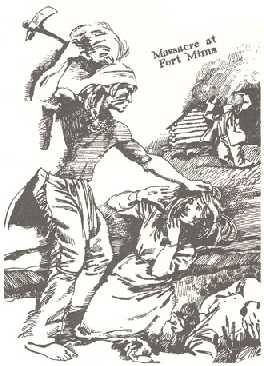
For nearly 20 years, the victim of an Indian arrow lay sprawled in front of a burning settler's cabin. In the 1970s, in the middle of the gas crisis, Disneyland turned off the flames for roughly a decade, Disneyland spokesman Ray Gomez said.
In 1984, the park began using a simulated flame and the settler was replaced with a moonshiner passed out on the porch. Then apparently even drunkenness became taboo for Disney.
"Now there's nothing out there but wildlife," Gomez said. "It just looks like an old abandoned cabin. The theme became how an animal habitat was endangered by a fire caused by a careless settler."
While some parents and activists have cheered the changes, many Disney fans fear political correctness is erasing parts of the park's history and charm.
"[It's] kind of silly," said Steve Premo, 47, of Santa Cruz, who complained that Disneyland often is held to an impossibly high standard.
"Ridiculous," scoffed John Vallejo, 39, of Anaheim. "It does nothing. It's caving in to pressure."
But for Disneyland officials, it's all part of the attractions' evolving story lines. Though animal-rights and gun activists didn't picket outside the park, Disney still wanted to be progressive.
"The fact of the matter is, we have to be responsive to what our guests tell us," Gomez said. "At the end of the day, they come here to experience what they want to experience, not stuff they might find out of place or out of date. . . . Anecdotes, jokes and actions that were funny or exciting then may not resonate now."
When the Jungle Cruise opened in 1955 as one of the park's original attractions, it was intended as a true-to-life journey down famous jungle rivers of the world. Over the years, it evolved into a mix of realism and corny jokes. But it remained a popular attraction staffed by "cast members" who fancied themselves stand-up comedians.
Many of those scripted jokes now are memorialized on Web sites paying homage to the eight-minute ride. Guests can often be heard reciting the hokey lines alongside the skippers garbed in khakis and a safari hat.
There are no death-defying thrills here—even the animal effects are incredibly low-tech. A hissing python ("You wouldn't want to be his main squeeze"). Fleeing adventurers being chased up a totem pole ("That rhino seems to be getting his point across, and I'm sure that guy on the bottom will get it in the end!). And frolicking elephants ("Go ahead and take pictures, they're wearing their trunks.").
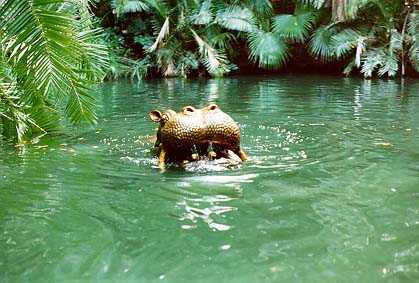
So when the boat slowed amid a river full of submerged bubble-blowing and ear-wiggling hippos, the skippers would lower their voice to a whisper and pause for effect, before warning: 'We've just entered a pool of dangerous hippopotami. Everybody be very quiet. Quiet."
Then, with perfect timing, a hippo would rise from the water, open-mouthed, teeth bared. The skipper would grab his gun, fire and everybody in the boat would jump.
DeForest still remembers his lines: "Scared 'em. Scared you guys. But like they say, the only real way to stop a hippo from charging is to take away his credit cards."
The jokes remain, but the hippos came and went without fanfare.
At Walt Disney World in Florida, the guns disappeared about the same time its newest park—Animal Kingdom, part zoo, part amusement park—opened in 1998. Officials decided it didn't seem right to have one park promoting wildlife and at the same time have employees at another shooting a wild animal.
"That's better," said Karla Jervis, 35, of Ohio, who recently rode the Jungle Cruise for the first time. " I wouldn't have taken the kids on the ride if it had guns. I don't even buy toy guns."
Debbie Leahy, a spokeswoman for People for the Ethical Treatment of Animals, also applauded Disney's actions as a step in the right direction. To those who think PETA and Disney need to lighten up, she said: "If it was a fantasy baby or fantasy toddler, I don't think somebody would find it funny. Clearly we should not be accepting it for a hippo. It's not humorous. It's really a form of animal cruelty."
Jamie O'Boyle, a Philadelphia-based cultural analyst who has studied Disneyland, said the changes are more about mainstreaming than political correctness. Few people would find stereotypical Indian raids or hippo poaching socially acceptable nowadays.
"As society's views change, the social message changes," O'Boyle said. "New generations grow up with new ideas. This is the way society evolves its norms and Disney has to reflect that."
In six months, only 10 people have lodged formal complaints with Disneyland over the change, although skipper Scott Nelson said people are constantly asking what happened to the firearms.

"We just tell them it was time for the guns to go," he said.
And not only from the attraction. This year, the park stopped selling all but space-age-style guns in Tomorrowland after a new state law went into effect requiring that toy weapons be brightly colored so as not to be mistaken for the real thing. Muskets, western guns and old flintlock-type weapons once popular in Frontierland and Adventureland were all removed from the shelves, Gomez said.
Mock frontier rifles in Fort Wilderness at Tom Sawyer Island also were removed in January, shortly after a 6-year-old girl lost part of her left index finger when she slipped and caught her finger on the rifle. Disney officials said they were in the process of taking out the guns when that accident occurred.
Disneyland has stopped short of removing all weaponry from the park. Marauding pirates are still armed, and just around the corner from the Jungle Cruise, the coin-operated shooting gallery in Frontierland still sees a steady stream of gunslingers.
Mixed messages? Maybe, but Gomez said: "Based on guest feedback, it is one of the most popular places in Frontierland. We have to strike a balance."
Copyright 2001 Los Angeles Times
Readers respond
Readers of the LA Times responded to the above article. From the LA Times, 9/8/01:
Disneyland Loses Some of Its Magic
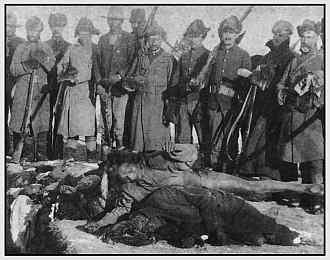
Re "Disneyland Is Now Safe for Hippos," Sept. 3: What happened to imagination and a little fun? Back in the mid-'60s, though not nearly as high-tech as it is today, the Disney park was a land all its own. I have vivid memories of some of the shows the Disney performers put on at the park. Shows that would be impossible today.
I will never forget the attack of Fort Wilderness on Tom Sawyer's Island. I watched in awe as actors dressed in Native American costume raided the fort as guests were taking a few minutes to drink something cool. Carrying tomahawks they sure looked like a mean bunch. Shortly thereafter the cavalry troops rescued the fort, with guns blazing, from those villainous Indians. The soldiers helped us kids handle the pretend rifles, defending the fort from the next group as they crossed the Rivers of America. It was the magic of Walt Disney back then that made one feel as if one were in another land, during another time, that is sorely lacking from the park these days.
GREG DILLER
Santa Monica
As a former jungle cruise skipper ('79-'80) who shot at many a mechanical hippo in my day (all to no apparent ill effect, either to hippo or park guests), I mourn the passing of common sense at Disneyland, where management grovels slavishly at the Temple of Current Political Correctness and skippers are disarmed once and for all, lest anyone's sensibility be offended. Surely, somewhere Walt is spinning in his refrigerator.
PAUL TAKAKJIAN
Pacific Palisades
In your article, former employee Mike DeForest asks, "What's next, disarming the Pirates of the Caribbean?" Good question. Perhaps a better question is why anyone ever thought the marauding activities of pirates to be amusing family entertainment? If you really want to know about the pirates of the Caribbean, I suggest you read James Michener's "Caribbean." The descriptions of rape, torture and other acts are appalling. That we should celebrate such behavior is a sad commentary on a sick society.
So, I suggest that the disarming of the Jungle Cruise boats is one small step toward rehabilitating a dysfunctional culture. Glorifying violence and putting toy guns in the hands of toddlers is surely responsible to some extent for the slaughter plaguing our schools and our streets across the nation. Let's look at violent behavior for what it truly is and stop desensitizing ourselves to the toll that it takes on our lives.
DAVID SALAHI
Laguna Niguel

Congratulations to Salahi for one sensible letter. As for Diller, he seems unaware that 1) most Indians didn't use tomahawks, 2) Indians are Americans, and 3) Indians are customers at Disneyland. I'd guess that Indian visitors wouldn't enjoy seeing their people portrayed as savages who deserve to get shot any more than Diller would enjoy seeing his people portrayed as savages who bayoneted innocent women and children.
Another stupid opinion
The following posting comes from the Something Awful website. It should be obvious why it qualified as "something awful":
In an article I read on the interweb, one helpful woman with a really stupid opinion had this to say about the recent removal of the side arms from the boat rides (which are now vulnerable to robotic hippo attacks):
"That's better," said Karla Jervis, 35, of Ohio, who rode the Jungle Cruise for the first time. "I wouldn't have taken the kids on the ride if it had guns. I don't even buy toy guns."
Had the entirety of Karla Jervis' statement been included it might have continued like this:
"I also don't let my kids look at pictures of guns in history books and if they ask me what Abraham Lincoln was killed with I tell them it was a noose," continued Karla Jervis. "I removed anything gun shaped from my house and when the kids watch TV I bang a pot with a spoon and turn the lights off and on whenever someone mentions or uses a gun."
Taking away guns and trying to convince your children that guns don't exist won't stop the violence in the United States. If someone can't shoot you with a gun they will shoot you with a knife, if you take away the knife they will shoot you with a truncheon, and so on until people are being shot in the streets with pillows and kittens.
This fiasco with Disney is just the latest in a long line of amusement park "mainstreaming", where older and less politically correct attractions are made more pleasant to the thin-skinned dopes of the 21st century. Some of these changes were pretty rational; others ruined perfectly fun rides by trying to homogenize everything into an annoyingly dull off-white pudding of dubious entertainment value.
Zack "Geist Editor" Parsons, http://www.somethingawful.com
Rob's reply
Unfortunately for Parsons's "logic," Jervis didn't argue for teaching children that guns don't exist. She implicitly argued for teaching them the opposite: how fatally real guns can be. That means teaching children you don't shoot animals and laugh it off.
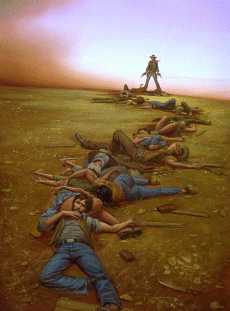
The Evidence Against Media Violence is overwhelming—much more than the likes of Parsons can handle. But rather than make a case that's already been made, let's see what else Parsons can tell us. Had the entirety of Parsons's statement been included it might have continued like this:
I mean, who the hell cares? It's a hippo and it's fake, right? People know the difference between real and fake. Although death-dealing kids cite video games, hard-core music, and movies as their inspiration, they don't really mean it. We know it's their parents' fault for working two jobs when they could be home.
We need to fight this pernicious 'political correctness' by any means possible. Here's what I say Disney should do. Set up a shooting gallery with little animatronic babies. Why not? Everyone knows shooting babies in a gallery is fake, so it can't hurt. It's obviously harmless and it'll teach those PC people a lesson.
Wait, I have a better idea. Why not make it a shooting gallery with animatronic adults? People can reenact famous scenes from history—like a video game, only better. For instance, they can shoot Indians dead, just like the Duke used to do. Hell, just like the visitors on Tom Sawyer's Island used to.
Or they can reenact their favorite assassinations. They can shoot Lincoln at Ford's Theater or JFK at Dallas. Or they can blast someone who's alive but deserves to die—someone they've been itching to off forever. Maybe the Pope...or Hillary Clinton...or Rush Limbaugh. The possibilities are endless.
Remember, it's all animatronic, and everyone knows the difference. This target shooting would be as harmless as shooting the fake hippo. So let's stop bowing to political correctness and start making Disneyland the fun place it could be. Let's make shooting and killing a central part of the Disney experience.
If Parsons really wants some fun, let's make animatronic models of his mother, wife, or child and riddle them with bullets. Why not? It's all harmless fun. As far as I'm concerned, a phony hippo deserves as much consideration as a phony Mrs. Parsons.
Plugging Mrs. Parsons will ensure that Disneyland doesn't become "an annoyingly dull off-white pudding of dubious entertainment value." And that's the goal, right? We can't have a moment of Parsons's fun ruined, can we?
In fact, with my plan the boat captains won't have to change their scripts. Disney simply will put an animatronic Mrs. Parsons in place of the animatronic hippo. As far as the jokes are concerned, one "fat hippo" will replace another.
Whee! We're having some politically incorrect fun now, aren't we, Zack? Yippee!

Politically incorrect, or just incorrect?
Disneyland's burning log cabin is a textbook example of how far our thinking has evolved and how far it has to go. Here are some quotes from a Disney site:
When you pass the burning cabin on the train you're told that some unlucky homesteader has accidentally set their house on fire. They used to say that the fire was started by attacking indians. I assume it was changed in order to be politically correct.
REPORTED: Jim Windisch 18 MAY 96
When riding the Riverboat on the Rivers of America, guests pass a burning log cabin. The log cabin actually used to have a settler slumped over a tree stump with a flaming arrow in his back, the victim of attacking indians. I assume he was taken out due to the violent aspect of this display.
CONFIRMED: anon 23 SEP 96
As a cast member and ride operator in Frontierland from 1969 to 1973 I often traveled past the burning cabin on Tom Sawyer's Island while piloting one of the two keelboats....At that time the burning cabin was said to have been the result of a stealthy indian arrow attack. This was a completely verifiable and historically accurate fact of life for early pioneers. The last time I was at Disneyland, while enjoying a cruise on the Mark Twain steamboat, I was almost sickened by the new "politically correct" reason that was given. What I saw was a bald eagle mother screeching at the baby eaglets in their nest about ten feet over the cabin. What I heard was even worse. The recorded spiel said that an inconsiderate settler had inadvertently set fire to his cabin, thus endangering himself and the environment around him. First, show me a bald eagle that builds a nest ten feet off the ground, and second, show me someone who can build a log cabin with only basic hand tools and then cannot contain a fire in a stone fireplace. I do not think this is at all verifiable or historically accurate.
UPDATE: anon 24 MAY 99
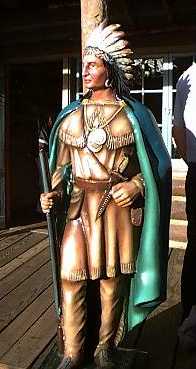
Rob's reply
There also used to be an "Indian chief" on horseback across the water from the log cabin, watching it burn. Even without the settler with an arrow in him, this tableau implied Indians were responsible for burning the cabin. I don't know if this chief is still watching.
This tableau may be "completely verifiable and historically accurate," but it's not at all typical or representative of the pioneer experience. For starters, log cabins are usually associated with the Eastern woods (e.g., Lincoln in Kentucky), while Indians in feather headdresses like our chief lived on the Great Plains. More important, there are few recorded attacks by Indians on the Euro-American interlopers who trespassed on their land. More often, the Indians helped the pioneers, who were about to expire because they were ignorant of the land and its ways.
In short, this tableau may have happened occasionally, but the reality is white invaders stealing Indian land and US troops enforcing their theft—usually in violation of lawful treaties. The burning log cabin is the remnant of a common American stereotype: the savage Indian. A more realistic tableau would show soldiers burning down a tipi—and shooting the Indians who tried to stop them, surrender, or flee.
I agree the "settlers burning down their own cabin" scenario is kind of silly. A random lightning strike seems more plausible to me. Or perhaps the fire could be the result of a deadly feud between cattle men and sheep men, or between Mormons and other Christians. But that would mean historical realities that don't implicate the largely innocent Indians. Oops.
More on Disneyland
Indians going to Disney World
"The lesson from this encounter with dancing and singing children, is that the state of our societies views on Natives, well sucks."
Related links
Political correctness defined
Pocahontas bastardizes real people
Pocahontas II: flawed again
"Marriage or bust" for Disney's women
|
. . . |

|
All material © copyright its original owners, except where noted.
Original text and pictures © copyright 2007 by Robert Schmidt.
Copyrighted material is posted under the Fair Use provision of the Copyright Act,
which allows copying for nonprofit educational uses including criticism and commentary.
Comments sent to the publisher become the property of Blue Corn Comics
and may be used in other postings without permission.